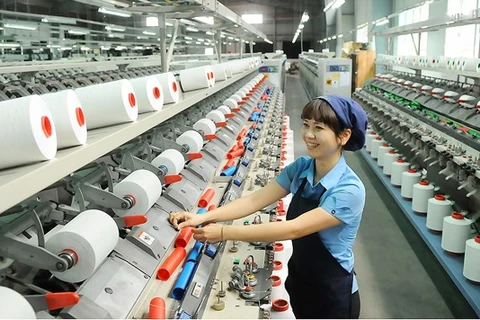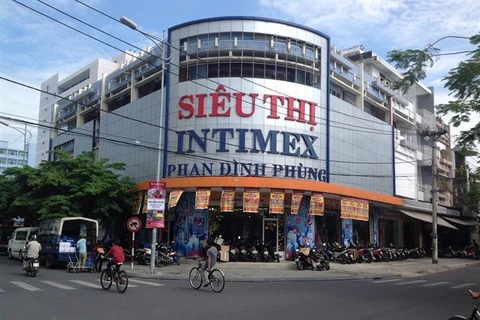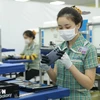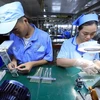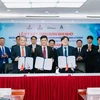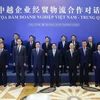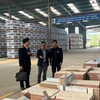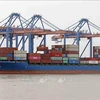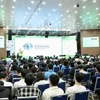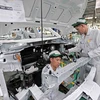Hanoi (VNA) - Domestic firms should make great efforts in the competition with foreign invested firms to contribute more actively to the global value chain and participate more effectively in the world’s production network, experts said.
Former director of the Central Institute for Economic Management (CIEM) Le Đang Doanh told Nguoi Lao Dong (The Labourer) newspaper that foreign direct investment (FDI) firms had greatly contributed to Vietnam’s economic growth, accounting for around 70 percent of national export turnover while domestic enterprises had not yet deeply involved in the global value chain.
According to the General Statistics Office, in 2016, Vietnam’s export turnover exceeded 175 billion USD, up 8.6 percent year-on-year. Of the estimate, the export value earned by FDI enterprises reached more than 120 billion USD, up 10.2 percent against the previous year.
Doanh said domestic enterprises had been urged to improve capacity and enhance competitiveness right when the contribution of FDI firms in the export value was standing at 50 percent. However, until now, when the rate had risen to 70 percent, local firms still remained passive in global value chains.
Export over the years contributed greatly to the economy - if in 2001, the national export turnover reached 15 billion USD, then 10 years later, the number rose up to 97 billion USD, Doanh said, adding that this achievement was largely achieved by the FDI sector.
The significant presence of FDI companies in exports partly reflected the low level of competitiveness exhibited by domestic businesses, he said, adding that a major part of Vietnamese firms were just joining in the low value outsourcing service industries.
According to Ngo Duc Hoa, chairman of Thang Loi Textile Garment JSC, all of Thang Loi’s products serving domestic use are self-designed, produced and distributed. But for the exported goods, the company just provides “cut and sew” services for foreign partners, meaning that the firm creates apparel and accessories out of materials owned by the foreign companies that contract them.
The biggest difficulty textile exporting enterprises is facing is the lack of raw materials for production, leading to the only option of importation. In addition, Vietnam’s textile and garment industry hasn’t thrived yet, thus gaining low attention from customers.
Due to the fact that the firm is only hired to “cut and sew” products for foreign partners, they have to use raw materials supplied by the partners or import the materials themselves. If an exported T-shirt costs 10 USD, the company has to spend 8.5 USD to import materials and earn only 1.5 USD for processing services.
"It is not an exaggeration to say textile enterprises pinch pennies for a living," Hoa said.
Even for high-technology industries such as power, electronic and telecommunication, most of domestic enterprises are hired for providing outsourcing services for exported goods.
According to Vu Thanh Tu Anh from Fullbright Teaching Program, a recent research of Fullbright’s specialist group summarising the 10-year period that Intel invested in Vietnam showed a number of sad results.
Tu Anh said Vietnamese enterprises account for only 3 percent of Intel’s total exporting value and are involved in some steps of meals provision, gift boxes preparation and security services, which are the services that Intel can’t import.-VNA
Former director of the Central Institute for Economic Management (CIEM) Le Đang Doanh told Nguoi Lao Dong (The Labourer) newspaper that foreign direct investment (FDI) firms had greatly contributed to Vietnam’s economic growth, accounting for around 70 percent of national export turnover while domestic enterprises had not yet deeply involved in the global value chain.
According to the General Statistics Office, in 2016, Vietnam’s export turnover exceeded 175 billion USD, up 8.6 percent year-on-year. Of the estimate, the export value earned by FDI enterprises reached more than 120 billion USD, up 10.2 percent against the previous year.
Doanh said domestic enterprises had been urged to improve capacity and enhance competitiveness right when the contribution of FDI firms in the export value was standing at 50 percent. However, until now, when the rate had risen to 70 percent, local firms still remained passive in global value chains.
Export over the years contributed greatly to the economy - if in 2001, the national export turnover reached 15 billion USD, then 10 years later, the number rose up to 97 billion USD, Doanh said, adding that this achievement was largely achieved by the FDI sector.
The significant presence of FDI companies in exports partly reflected the low level of competitiveness exhibited by domestic businesses, he said, adding that a major part of Vietnamese firms were just joining in the low value outsourcing service industries.
According to Ngo Duc Hoa, chairman of Thang Loi Textile Garment JSC, all of Thang Loi’s products serving domestic use are self-designed, produced and distributed. But for the exported goods, the company just provides “cut and sew” services for foreign partners, meaning that the firm creates apparel and accessories out of materials owned by the foreign companies that contract them.
The biggest difficulty textile exporting enterprises is facing is the lack of raw materials for production, leading to the only option of importation. In addition, Vietnam’s textile and garment industry hasn’t thrived yet, thus gaining low attention from customers.
Due to the fact that the firm is only hired to “cut and sew” products for foreign partners, they have to use raw materials supplied by the partners or import the materials themselves. If an exported T-shirt costs 10 USD, the company has to spend 8.5 USD to import materials and earn only 1.5 USD for processing services.
"It is not an exaggeration to say textile enterprises pinch pennies for a living," Hoa said.
Even for high-technology industries such as power, electronic and telecommunication, most of domestic enterprises are hired for providing outsourcing services for exported goods.
According to Vu Thanh Tu Anh from Fullbright Teaching Program, a recent research of Fullbright’s specialist group summarising the 10-year period that Intel invested in Vietnam showed a number of sad results.
Tu Anh said Vietnamese enterprises account for only 3 percent of Intel’s total exporting value and are involved in some steps of meals provision, gift boxes preparation and security services, which are the services that Intel can’t import.-VNA
VNA

